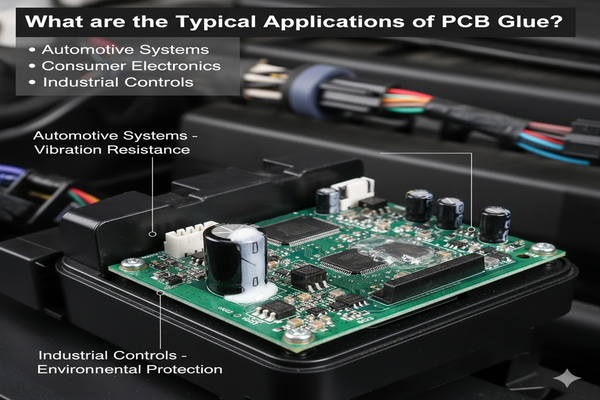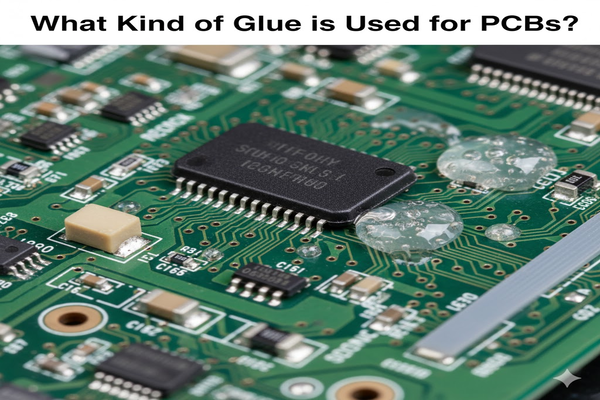Are your circuit boards failing? Do you struggle with component reliability? You need the right adhesive solution1.
PCBs use various glues like epoxies2, silicones3, and urethanes4. These adhesives secure components, provide insulation, and protect against environmental factors5, ensuring durable and reliable electronic assemblies.
Understanding the right adhesive for your PCB can be confusing. But getting it right makes all the difference for your electronics. Let’s dive into the specifics of what makes a good PCB glue and why it matters so much for your projects.
Common Types of PCB Glue for Circuit Boards?
Component detachment causing headaches? Environmental stress damaging your boards? The right glue is your answer.
Common PCB glues include epoxies for strong bonds, silicones for flexibility and temperature resistance, and urethanes for moisture protection6. Each type serves specific needs in circuit board assembly and protection.

When I first started working with electronics, I thought all glues were the same. I quickly learned that using the wrong type could ruin a whole project. There are three main types of adhesives we often use.
Epoxy Resins
Epoxy resins are very strong. They create a hard, permanent bond. I use them when I need something to stay put forever. They resist heat and chemicals well.
Silicone Adhesives
Silicones are flexible. They handle temperature changes without cracking. This is great for parts that might expand or contract. I use silicones for sensitive components that need vibration damping7.
Urethane Adhesives
Urethanes offer good moisture resistance. They are also flexible. I often pick urethanes for applications where water exposure is a concern.
| Glue Type | Strength | Flexibility | Heat Resistance | Moisture Resistance | Common Use |
|---|---|---|---|---|---|
| Epoxy | High | Low | High | Medium | Component bonding |
| Silicone | Medium | High | High | High | Vibration damping |
| Urethane | Medium | Medium | Medium | High | Environmental sealing |
Why use Glue in PCBs?
Worried about component shifting? Need better protection for your circuits? Glue is the hidden hero.
Glue in PCBs secures components, provides insulation, and protects against moisture, dust, and vibration. It increases the reliability and lifespan of electronic devices, preventing failures due to environmental stress or physical movement.

I remember a time when a critical component vibrated loose on a board I was testing. That's when I truly understood the importance of adhesives. Glue does more than just hold things together.
Component Fixation
The main job is to fix parts. Small surface-mount devices (SMDs) need glue to stay on the board during soldering. Larger through-hole components also benefit from glue to prevent movement. This helps stop damage during assembly or use.
Environmental Protection
PCBs face many threats. Moisture, dust, and chemicals can cause shorts or corrosion. Glue acts as a barrier. Conformal coatings, often a type of glue, seal the entire board. I've seen boards last much longer in harsh conditions because of this protection. My insights tell me that conformal adhesives, like the transparent and yellow varieties, are excellent for moisture-proofing, salt-spray-proofing, and mildew-proofing.
Thermal Management
Some glues help with heat. They can transfer heat away from hot components. This stops parts from overheating. For example, I use thermally conductive adhesives for power components.
Vibration and Shock Absorption
Electronics often face bumps and shakes. Glue can cushion components. This stops them from breaking off. It's like a tiny shock absorber for your parts.
What are the Typical Applications of PCB Glue?
Curious where PCB glues truly shine? Wondering about their real-world impact? Their applications are everywhere.
PCB glues are used in consumer electronics for component attachment, in automotive systems for vibration resistance, and in industrial controls for environmental protection. They are crucial for device reliability across various sectors.

I've worked on projects where the application dictated the glue choice. From everyday gadgets to critical industrial systems, glue plays a key role.
Consumer Electronics
Think about your phone or laptop. Inside, tiny parts are glued down. This stops them from moving when you drop the device. I've used glue to secure microchips and connectors in small devices. It helps them survive daily use.
Automotive Industry
Cars face lots of vibration and temperature changes. PCBs in cars need super strong and flexible glues. This ensures things like engine control units (ECUs) keep working. I've worked on automotive boards where silicone-based adhesives were critical for reliability.
Industrial Control Systems
Factories use tough machines. Their electronics need to withstand dust, oil, and extreme temperatures. Here, I use glues that offer robust environmental protection. Potting compounds, which are a type of glue, encapsulate entire circuits. This makes them almost indestructible in harsh conditions. My insights highlight that black potting compound is used for encapsulation and fixation and cannot be removed once applied.
Medical Devices
Medical equipment needs to be highly reliable and often sterilized. Glues used here must be biocompatible8 and very stable. I've seen specialized epoxies used for sensors in medical devices.
What Types of Glue are Best for Circuit Boards?
Struggling to pick the right adhesive? Unsure which glue offers the best performance? The best choice depends on your needs.
The best glue for a circuit board depends on factors like required strength, flexibility, temperature resistance, and environmental exposure. Epoxies offer strong bonds, silicones provide flexibility, and urethanes excel in moisture protection.

Choosing the right glue is like picking the right tool for a job. If you use a hammer for a screw, it won't work well. I always consider several things when making my choice.
Material Compatibility
First, the glue must stick to the PCB material and the components. Some glues work better with certain plastics or metals. I always check the data sheet for compatibility.
Curing Method
How does the glue harden? Some need heat, some need UV light, and some just air dry. This affects production time. I pick a curing method9 that fits our manufacturing process.
Performance Requirements
Does it need to be super strong? Does it need to bend a lot? Will it get very hot or very cold? I match the glue's properties to the board's needs. For example, if a board needs to be very moisture-proof, I'll lean towards urethanes or conformal coatings10. My insights confirm that conformal adhesives are excellent for moisture, salt-spray, and mildew protection.
Cost
Cost is always a factor. More specialized glues can be expensive. I balance performance with budget.
| Factor | Consideration | Example Choice |
|---|---|---|
| Strength | Holding heavy components firmly | Epoxy |
| Flexibility | Withstanding vibration or thermal cycling | Silicone |
| Temperature Range | Operating in extreme hot or cold | High-temp epoxy/silicone |
| Environmental | Protection from water, chemicals, dust | Urethane, Conformal coating |
| Curing Time | Speed of production | UV-curable adhesive |
How to Remove PCB Glue?
Made a mistake with your glue application? Need to rework a component? Removing PCB glue can be tricky.
Removing PCB glue often involves mechanical methods like scraping or chemical solvents11. The specific technique depends on the glue type and the need to protect underlying components. Always proceed with caution to avoid damaging the board.

I've been in situations where I had to remove glue. It’s rarely easy, and it requires patience. The method depends heavily on the type of glue used.
Mechanical Removal
For hard glues like some epoxies, I sometimes have to carefully scrape it away. I use small tools, like plastic spatulas or specialized picks. The goal is to remove the glue without scratching the PCB or damaging components. Heat can sometimes soften the glue, making it easier to scrape.
Chemical Removal
Softer glues, like some silicones or urethanes, can often be removed with chemical solvents. I use isopropyl alcohol (IPA) or other specific solvents recommended by the glue manufacturer. I always test a small, hidden area first to make sure the solvent doesn't harm the PCB or other components. I apply the solvent, let it sit, and then gently wipe or pick away the softened glue.
Specialized Removal Techniques
Some very strong glues or potting compounds12 are designed to be permanent. My insights confirm that black potting compound, once applied, cannot be removed. For these, removal might not be possible without destroying the component or the board. In such cases, replacing the entire board or component might be the only option. Always check the glue's specifications before applying it, especially if future rework is a possibility.
| Glue Type | Removal Method | Caution |
|---|---|---|
| Standard Epoxy | Mechanical scraping, heat | Avoid damaging traces/components |
| Silicone | Solvents (IPA), gentle scraping | Check solvent compatibility |
| Urethane | Solvents, careful picking | Ensure no residue remains |
| Potting Compound | Generally not removable | May require board replacement |
Conclusion
Choosing the right PCB glue ensures durability and performance. Consider type, application, and removal to protect your electronics effectively.
Explore various adhesive solutions tailored for circuit board applications. ↩
Explore how epoxies provide strong bonds and durability for circuit boards. ↩
Learn about the flexibility and temperature resistance silicones offer for sensitive components. ↩
Discover how urethanes protect against moisture and enhance circuit board longevity. ↩
Understand the environmental challenges that can impact the performance of PCBs. ↩
Explore the significance of moisture protection in ensuring PCB reliability. ↩
Discover the importance of vibration damping for sensitive electronic components. ↩
Discover the importance of biocompatible adhesives in medical device applications. ↩
Learn about various curing methods and their impact on adhesive performance. ↩
Learn how conformal coatings can enhance the durability of your circuit boards. ↩
Learn about safe chemical solvents for effective glue removal on PCBs. ↩
Explore how potting compounds provide robust protection for electronic circuits. ↩



